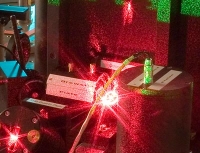
[2010-03-14] In Nature Physics researchers from Innsbruck and Stuttgart propose a new type of universal quantum simulator based on Rydberg atoms stored in optical lattices.
Cold atoms in optical lattices, which are formed by counterpropagating laser beams, represent a many-particle quantum system, where the atomic interactions and dynamics of the particles can be controlled at a microscopic level by external fields. This high level of control and flexibility offers the possibility to use these systems as quantum simulators, i.e. as devices which can mimic the behavior of other complex many body quantum systems and allow to study their properties, dynamics and phases.
Together with the group of Hans-Peter Büchler from the University of Stuttgart Innsbruck’s Peter Zoller, Markus Müller, and Igor Lesanovsky (now at the University of Nottingham) have proposed and analyzed a new quantum simulator based on Rydberg atoms.
In their work the authors suggest to store cold atoms in deep lattices such that the atoms do not hop between the lattice sites and can be used to encode quantum bits in different electronic states of the atoms. Interestingly, although the atoms sit at different sites and do not collide it is possible to induce very strong interactions between atoms separated by distances of several micrometers. This can be achieved by exciting them to electronically high-lying Rydberg states. It has been suggested theoretically one decade ago and now been demonstrated in remarkable experiments in several laboratories that these Rydberg interactions offer the possibility to realize fast quantum gates between remote atoms. Motivated by and building on these achievements, the researchers have developed a digital Rydberg simulator architecture based on sequences of fast and efficient quantum gates between Rydberg atoms. This 'digital' simulator offers promising perspectives for the simulation of complex spin models, which are of great interest both in quantum information science, and condensed matter, and high-energy physics.